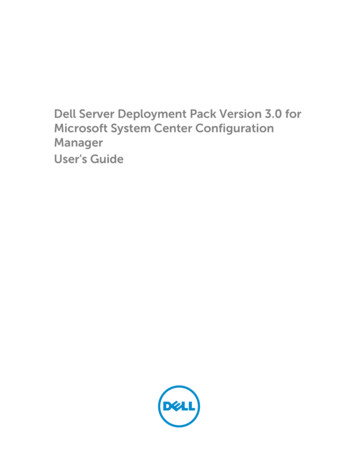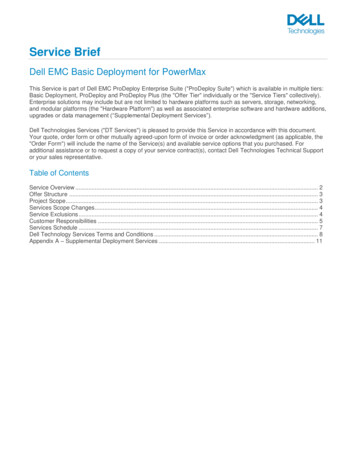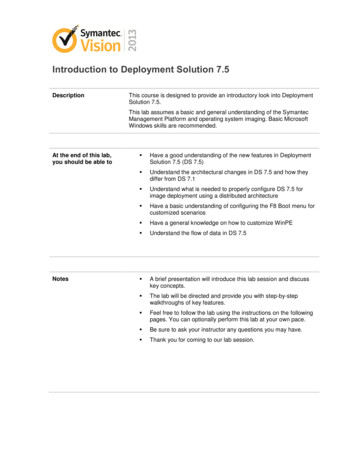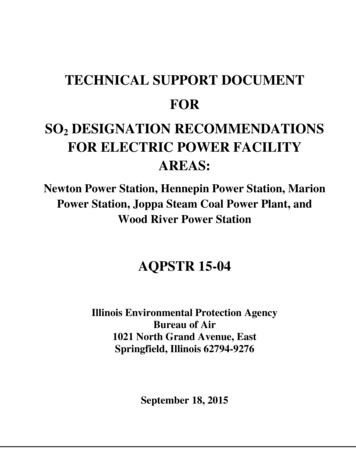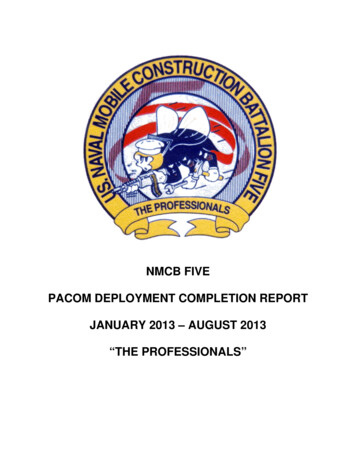
Transcription
NMCB FIVEPACOM DEPLOYMENT COMPLETION REPORTJANUARY 2013 – AUGUST 2013“THE PROFESSIONALS”
TABLE OF CONTENTSCHAPTERIIIIIIIVExecutive SummaryAdministrationPublic onsMain BodyAlfa CompanyBarlie CompanyProject SummariesOIC Discretionary ProjectsCamp MaintenanceLabor DistributionYokosuka, JapanProject SummariesOIC Discretionary ProjectsCamp MaintenanceLabor DistributionSasebo, JapanProject SummariesCamp MaintenanceLabor DistributionAtsugi, JapanProject SummariesLabor DistributionChinhae, South KoreaProject SummariesOIC Discretionary ProjectsCamp MaintenanceLabor DistributionDiego GarciaProject SummariesOIC Discretionary ProjectsCamp MaintenanceLabor DistributionChina LakeProject SummariesGuamTimor LesteProject SummariesOIC Discretionary ProjectsCamp MaintenanceLabor 1444747485052535556575859616364656667687274848586
VVIPalawan, PhilippinesProject SummariesOIC Discretionary ProjectsCamp MaintenanceLabor DistributionCambodiaProject SummariesOIC Discretionary ProjectsCamp MaintenanceLabor DistributionExercisesCobra GoldBalikatanCJLOTSCARATPacific PartnershipADMM PlusIntelligenceLogisticsSupplyEquipment ManagementMaintenance and Material Management 123134136138138150153153
CHAPTER ONEEXECUTIVE SUMMARY1. NMCB 5 tackled some great challenges during the 2013 PACOMdeployment. While conducting dispersed operations throughouteleven countries in PACOM, NMCB 5 consistently set the standardin professionalism, tactical proficiency, family readiness andmission accomplishment.a. Administrative. The Administrative/Personnel Officeprocessed 48 transfers, 56 receipts, 50 reenlistments and 112advancements during this deployment. Additionally, theBattalion deployed to PACOM with 100% dental readiness andmaintained readiness well above 98% throughout deployment. TheDental Department provided care for 350 patients, delivered 60Kworth of dentistry and improved the digital radiographcapabilities of the Camp Shields dental clinic.b. Training/Readiness. Completing a seven month PACOMdeployment, NMCB 5 maintained 93% total skills attainment perthe requirements set forth in COMFIRSTNCDINST 3502.2. In orderto achieve high levels of training attainment for the follow-onEUCOM/AFRICOM deployment, training has requested 4,619 seatsduring the upcoming homeport as specified in the chart below.Additionally, NMCB 5 will take advantage of UDT, STT and otherprograms at the Battalion, Company and Special Org level toaugment current skill requirements and proficiency. The endstate is a Battalion that is fully mission capable and at thehighest levels of operational readiness prior to the nextdeployment cycle.c. Operations. NMCB 5 deployed its Main Body to CampShields, Okinawa, Japan and dispersed six Construction ReadinessOperation (CRO) details across mainland Japan, Diego Garcia,South Korea, and the United States; three Construction CivilAction Detail (CCAD) sites in Cambodia, Timor Leste, and thePhilippines; and supported nine Theater Security Cooperation(TSC) exercises in Thailand, the Philippines, South Korea,Indonesia, Malaysia, Western Samoa, and Tonga. NMCB 5’s commandand control ranged over 10,000 nautical miles from China Lake,CA to Diego Garcia with its Seabees expending over 20K mandayswidely dispersed amongst 20 detail sites in 13 differentcountries throughout the Pacific.d. Logistics. Upon arrival on Camp Shields, NMCB 5coordinated a complex and efficient turnover with NMCB 74,4
including the subsequent Battalion Equipment Evaluation Program(BEEP) of 404 units of Civil Engineer Support Equipment (CESE)and a P25 Table of Allowance (TOA) valued at 60M. The BEEPspanned across seven countries in the PACOM AOR and theBattalion sustained a 98% CESE availability rate. Additionally,the Battalion revitalized the TOA through an aggressive wall-towall inventory resulting in the highest level of TOA readinesssince the P25 was refreshed in 2008. As a result, NMCB 5ensured all construction, tactical equipment, and communicationsassets were on hand and ready to support a Major CombatOperation (MCO) response, TSC and HumanitarianAssistance/Disaster Relief (HA/DR) missions in support ofPacific Fleet’s maritime strategy.5
CHAPTER TWOADMINISTRATIONThe Administrative/Personnel Office processed 48 transfers, 56receipts, 50 reenlistments and 112 advancements during thisdeployment. The following statistics highlights theadministrative aluations/FitnessReports3594221ADVANCEMENTSTime-in y 1st Term2nd Term3rd TermCareerEligible4218141 January through 31 JulyNot %Navy57%69%78%67%
PUBLIC AFFAIRSThe Public Affairs Office (PAO) was actively engaged coveringevents throughout the deployment. Overall, 15K photos weretaken and 35 articles were written along including over 200captioned photos. Photos were published in a variety of outletsto include The Ventura County Star, The Lighthouse, the Navy.milwebsite, Seabee Magazine, DVIDS, and the DefenseImagery.mil,PACOM.mil, and CPF.navy.mil websites.Stories released included topics about NMCB 5 involvement inCooperation Afloat Readiness and Training (CARAT) exercises,Construction Civic Action Detail (CCAD) sites, PacificPartnership 2013 (PP13), Construction Readiness Operations (CRO)Projects, the 2013 Seabee Ball, NMCB 5 Change of Command andmore.NMCB 5 also continues to lead the charge for use of Facebook asan effective promotion and communication tool. The PAOharnessed the power of social media with the largest fan base ofany NCF organization at more than 4K fans to date. Family andfriends are provided regular access to weekly happenings, whilethe battalion is in homeport or deployed, including battalionevents, reenlistments, awards, SCW pinnings, project work andany other accomplishments.Apart from strategic communications external to the command, thePAO also created a deployment cruise book. The cruise bookcaptured up-to-date photos of all 570 plus members of thecommand in addition to photos of NMCB 5’s Seabees hard at workand play. The book is also a critical piece of the commandoperations report submitted each year for historicalpreservation.NMCB 5’s PAO contributions on this deployment positivelyincreased the NCF’s strategic communications in order to ensurethe critical roles Seabees play in today’s Navy were showcased.Media Outlets: Facebook: https://www.facebook.com/NMCB5 Navy.mil: http://www.public.navy.mil/ DVIDS: http://www.dvidshub.net/unit/NMCB57
CHAPTER THREETRAININGCompleting a seven month PACOM deployment, NMCB 5 maintained 93%total skills attainment per the requirements set forth inCOMFIRSTNCDINST 3502.2. In order to achieve high levels oftraining attainment for the follow-on EUCOM/AFRICOM deployment,NMCB 5 requested 4,619 seats during the upcoming homeport asspecified in the chart below. Additionally, NMCB 5 will takeadvantage of UDT, STT and other programs at the Battalion,Company and Special Org level to augment current skillrequirements and proficiency. The end state is a battalion thatis fully mission capable and at the highest levels ofoperational readiness prior to the next deployment cycle.Homeport Projected Class Training1400120010008006004002000# Seats AcquiredAugSepOctNov DecJan'14FebMarAprMay JunJulAugSepOctNov DecJan'15Maintenance Phas eSilver Flag Exercise. Members of the Battalion participated inthe Silver Flag Exercise conducted by Detachment 1, 554th RapidEngineer Deployable Heavy Operational Repair Squadron Engineers(RED HORSE) Squadron (RHS), 36th Contingency Response Group, 36thWing, Pacific Air Forces (PACAF) at Kadena AFB from 16APR13 to24APR13. The Exercise provided critical contingency-orientedskill qualifications to constructionforces in key positions throughout theCivil Engineer and Force Support units,placing emphasis on team and individualqualifications. Integrating with theirAir Force Counterparts, Seabees trainingin Airfield Damage Repair (ADR) and forcebed down practices attended a rigorousclass schedule centered on Engineering,Power Production, Structures,Expeditionary Airfield Lighting Systems(EALS), and Equipment and Pavement. As afinal event, Seabees were able to8
demonstrate their newly acquiredskills with a day-long ADR exercisewhich included U.S. Marines fromKadena’s CBRN group to incorporatesimulated CBR attacks, downedutilities, tent fires and masscasualties into the scenario.Utilizing the joint trainingopportunity, NMCB 5 gained valuablein-rate and team skills, learned fromAir Force best practices, and were able to cross train in nontraditional equipment including Mobile Airfield Arresting System(MAAS), Folding Fiberglass Matting (FFM) and 2 Megawatt dieselgenerators. Overall, the exercise enhanced the NavalConstruction Force and Air Force preparedness to integrate infuture joint operations.Training Skills Assessment Program (TSAP). The TSAP programcontinues to face administrative and execution challenges. The2013 PACOM deployment had the Battalion spread to 13 smalldetail sites across the Pacific Area of Operations. Absence ofSubject Matter Experts at various locations prevented severalsites from endorsing the demonstration of specific skills. Asthe Battalion enters homeport, increased focus on assigning SMEswill be essential to ensuring success of the program. Currentnumbers have 17 skills attained throughout the Battalion duringdeployment. However, other methods of qualification andcertification were also used to maintain the overall skillsattainment within the battalion. The absence of TSAP appointedqualifications was not detrimental to the readiness levels orability to execute assigned tasking.Seabee Combat Warfare Specialist (SCWS) Program. The battalionmaintained a robust SCWS program throughout the duration ofdeployment. Demonstrating combined efforts of the trainingdepartment, detail and company representatives and other commandSCW qualified personnel, the battalion conducted over 60 reviewcourses, administered over 100 exams, and executed 65 boards.This resulted in the battalion awarding 76 SCW qualificationsduring the seven month deployment and increased the NMCB 5 SCWqualification rate from 65% to 72%.9
SCWS ProgramEnlisted Personnel30Total Achieved2520ClassesPart 115Part 2Part -13MonthWeapons. Utilizing the small arms range at Camp Schwab, NMCB 5effectively maintained the battalion’s navy pistol and riflequalifications achieving 20 M-9and 39 M-16 qualifications at theMain Body site and maintained an86% qualification rate at the endof the deployment period.Additionally, armory personnelexcellently managed the inventory,circulation and turn-in of 420 M16 rifles, 40 M203s and 8 Shotguns.The armory crew handled allmaintenance and shippingrequirements ensuring a seamlesstransition for the follow-on battalion and effectively replacingall rifles in the Okinawa Armory TOA.MILBLOCK Training. NMCB 5 leveraged opportunities inherent tothe Camp Shields deployment site in the execution of thecommand’s week long Military Block Training from 6MAY13 to11MAY13. Traditional training applications were combined withteam building exercises to develop and reinforce the practicalapplication of Seabee Combat Warfare skills. The elaboratetraining events culminated in a box car competition designed toreinforce logistical management, planning and estimating, ClassIV materials requisition and project execution. The events ofthe MILBLOCK week not only proved valuable in the reinforcementof essential skills, but contributed positively to command10
camaraderie and pride. Several departments ran trainingconcurrently during the MILBLOCK week. The Battalion MedicalDepartment identified local training opportunities enablingeight personnel to become qualified as CPR/Basic Life SupportInstructors. The Operations Department coordinated with NECCPAC to provide war-fighter seminars, providing battalion leaderswith accurate, up-to-date assessment tools to make informedmission and project management decisions. Details departing forMalaysia, Thailand, and Indonesia utilized on-site mobiletraining teams to develop skills in new constructiontechnologies including Saebi Alternative Building System (SABS)and Explosive Remnants of War (ERW)containments. Finally, theCommunications Department workeddiligently, successfully employingthe Rapidly Deployable SatelliteTerminal (RDSAT)/Broadband Reachback system to update the TacticalData Network (TDN) therebymaintaining certification of thenetwork system.11
CHAPTER FOURSAFETY/OPERATIONSSAFETYSafety was paramount to the success of the Battalion during the2013 PACOM Deployment. Safety’s priority was to ensure allBattalion personnel align to the standards set forth inOccupational and Safety Health Association (OSHA) and amplifyingNAVFAC safety instructions. Safety also ensured that eachproject followed their project safety plans and utilizeddetailed Operational Risk Management (ORM) decision makingduring planning and execution to ensure all hazards wereidentified and adequate controls were put in place to mitigaterisk.543210CobraGsdolaenepillinhhiaClass "D" On-dutyiPhCgiukosutskYoAadioOboamGIEOOOOClass "C" Off-DutybseSaCD-C-C-C-CGHBAClass "C" On-DutyClass "D" Off-dutyDuring the deployment, NMCB 5’s safety campaign provedsuccessful by completing the deployment with only two lost timemishaps. Keys to the battalion’s success lied in the followingfocus areas.a. ORM. Operational Risk Management was fully integratedinto all project planning, taught to all hands and used as theprimary basis for the development of project Safety Plans.b. In-house safety. Inspection programs focused onteaching safety standards in the field rather than in theclassroom and assisting crews in prioritizing their corrective12
efforts by integrating the use of RAC Codes into daily projectsafety inspections. Safety Officers assisted crews indeveloping and implementing control solutions to meet the intentof all written safety and risk management standards withouthindering operations.c. Motivation. The Safety Office was able to motivatetroops and leadership to ensure the Battalion’s focus neverstrayed from mission safety. Programs, such as the Safe Seabeeof the Quarter award and spot safety awards given to crews thattook no ‘hits’ on daily job site inspections helped to reinforcedaily job site safety lectures.d. Aggressive Surveillance. Monthly Mishap Review Boardswere conducted to review any possible developing trends andallow for the timely implementation of necessary correctiveprocedures to mitigate any hazards.e. Safety Meetings. Monthly Enlisted Safety Committeemeetings with all Company and Detail Safety Representatives wereheld to discuss training, review safety programs and policies,as well as discuss any current safety issues or questions withregards to new construction methods or non work relatedrecreational activities, such as the Motorcycle Safety Program.Additionally, monthly OSHROC meetings enabled our staff toreview any concerns that were brought up during the EnlistedSafety Committee meetings and were then addressed to the command,discussed and reviewed.f. Reporting. Mishap reports were reported via chain ofcommand as prescribed and as they occurred in a timely manner.All Class D and above, to include near mishaps, were recordedinto ESAMS. Additionally, Health and Tone of the Battalionmetrics were kept current to identify trends early and mitigaterisk.13
DEPLOYMENT TOTALSFatalities# Lost Days# Lost DayCases# Light DutyDays# Light DutyDay Cases# First AidMishaps# GovtVehicleMishapsTotal NumberMishapsGovt VehicleRepair CostsGovt VehicleMiles DrivenJan 1300Feb 1300Mar 1300Apr 1309May 13014Jun 1300Jul 0220172121110871011672144 2,305 500 0 150 4,500 350 0 968Jan 13Feb 13Mar 13Apr 13May 13Jun 13Jul 30501000202010140Jan 13Feb 13Mar 13Apr 13May 13Jun 13Jul 13Total000000000001121151421101020ON-DUTY MISHAPSCases LostWork DaysLost WorkDaysCases LightDuty DaysLight DutyDaysFirst AidMishapsFatalitiesOFF-DUTY MISHAPSCases LostWork DaysLost WorkDaysCases LightDuty DaysLight DutyDaysFirst 40
OPERATIONSThroughout the deployment, NMCB 5 expended over 20K mandayssupporting 17 CRO projects worth over 6M at sites in mainlandJapan, Okinawa, Diego Garcia, Korea and China Lake, CA. NMCB 5successfully completed three PEB projects, a bollard projectconsisting of 766 individual security bollards, a 600 squarefoot CMU stock room, three concrete gazebos, 13 bus stopshelters, and produced 6K cubic yards of aggregate material ator ahead of schedule. In addition, the Battalion efficientlyand seamlessly turned over seven extended duration CRO projectsto NMCB 3 prior to redeploying back to CONUS, enabling futureNCF mission success.NMCB 5 delivered its greatest strategic impact to the PacificFleet maritime strategy through its enduring presence at threeCCAD sites and nine DOD exercises directly supporting both theIII Marine Expeditionary Force (III MEF) and Pacific Fleet(PACFLT). NMCB 5’s participating personnel were directlypartnered with nine different Pacific host nation militaries andthe mission focused on strengthening PACOM regional alliances.The three CCAD sites expended over 8K mandays resulting in thecompletion of five 300 foot water wells in Cambodia, two newschools in the Philippines, and major renovations for twoschools in Timor Leste totaling over 2.5M. In addition to thetasked work at the three CCAD sites, the Battalion also plannedand executed seven successful community relations projects,contributing to mission success by advancing the relationshipswith the citizens and militaries of the host nation.NMCB 5’s exercise support was highlighted by the completion ofthree category five hurricane proof Saebi Alternative BuildingSystems (SABS), three Explosive Remnants of War (ERW) bins (tobe used by the local villagers to store found UXO), two threeroom CMU block classrooms, and a 70 meter long steel cablesuspension footbridge that was the first of its kind everconstructed by the U.S. Naval Construction Forces. All of theexercises were executed while partnered with the host nation’smilitary and each project directly benefitted their respectivecitizens by completing an engineering project that specificallyaddressed the needs identified by the local host nationgovernments. By partnering and sharing construction methodologyduring each exercise, both U.S. and host nation militaryengineers increased their capabilities to respond to HA/DRefforts, fostered critical regional associations, and helpedachieve the U.S. Pacific Fleet mission of protecting and15
defending the collective maritime interests of the United Statesand its allies and partners in the Asia-Pacific region.ALFA COMPANYAlfa Company was responsible for horizontal construction, cranes,CESE maintenance and overall transportation for the Battalionduring the 2013 PACOM deployment. Successfully completing allassigned tasking, Alfa Company realized across the boardachievements with a focus on safety, quality and processimprovement.Alfa Company hit the ground runningin January 2013 with its AdvancedParty pairing up with NMCB 74personnel to commence turnover.Working nonstop, the two Battalionsconducted a seamless BattalionEquipment Evaluation Program (BEEP),inspecting and turning over 406 unitsof CESE valued at 42.5M. The smoothtransfer of authority in each shopand concentrated focus by both Battalions helped complete theBEEP five days ahead of schedule with zero discrepancies.Praised by the 30NCR team assisting the BEEP, NMCB 5 receivedits deployment BEEP tasking which focused in part on corrosioncontrol, disposition of Legacy equipment and processimprovements in the Crane Program.During the BEEP, the Navy Crane Center conducted an audit ofboth the NMCB 74 and NMCB 5 Crane Programs, thoroughlyinspecting the four cranes aboard Camp Shields, observing ajoint lift conducted by both Battalions and evaluating theoverall Crane Safety of the companies. With zero discrepancies,both Battalions passed the NCC Audit and were given a greenlight to continue their crane operations. In addition to theNCC Audit, the Alfa Company CraneCrew had a successful deployment,recertifying a 40 Ton crane and aCategory 4 Mk 36 MTVR Wrecker.Additionally, they conducted semiweekly lifts in the yard, increasingfamiliarity with the equipment anddeveloping their cohesion as a team.From the unending corrosion controlmeasures required on the wire ropeto both Construction Mechanics16
obtaining their licenses on the MTVR Wrecker, the Crane Crewincreased the operational readiness of the Battalion.The month of January was especially busy for Alfa personnel asthe Battalion moved immediately into a Mount-Out Exercisesimulating the stand-up of the Air Detachment. While cleaning,inspecting and dispatching 32 units of CESE for embarkation,Alfa Company personnel worked around the clock and earnedaccolades from the 30NCR’s exercise evaluators for theirtireless efforts and attention to detail.With the success of the Mount-Out Exercise behind them, theBattalion moved on to its Operational Readiness Inspection (ORI).While successfully passing the ORI, the 30NCR inspection teamidentified a discrepancy in the Company’s licensing program.During a spot check, the evaluators discovered license recordsmissing copies of the required written examinations. Thisdiscrepancy turned into a deployment long focus area for theCompany, as the License Examiner and a staff of EquipmentOperators thoroughly reviewed 556 individual license records forthe Battalion, many containing multiple equipment licenses, andre-administered every deficient written exam or pulled theequipment license from the license folder. With a systematicapproach, the team started with the equipment operators andBattalion personnel operating CESE in PACOM first, then moved onto Alfa Company and finally the remainder of the Battalion.While a challenging task, the License Examiner and crew wereable to correct Alfa Company’s ORI discrepancy prior toredeployment, successfully scrubbing license records for theentire Battalion and restructuring the licensing process forfuture operations.17
Alfa Company EquipmentOperators were spread acrossfive Okinawa CRO projects wherethey operated graders, loaders,backhoes and skid steers onvarious projects in addition toproviding daily jobsitetransportation to BarlieCompany troops. In theevenings and weekends, the EOsdirectly bolstered the morale of the Battalion with bus and taxiservice to Kadena AFB and surrounding USMC bases. Each evening,duty EOs operated the MWR bus transporting NMCB 5 personnel tothe Kadena exchange to purchase personal supply items as well asproviding access the Kadena MWR facilities.Due to the oversize vehicle restrictions on the island’sroadways, Alfa Company was required to conduct all line haul andCESE movements to the port after midnight. Without complaintand enduring long workdays, theEOs conducted over 40 midnightruns to transport CESE to variousprojects and to retrieve CESE insupport of the various PACOMExercises. Of note, duringembarkation for ExerciseBalikatan 2013, Alfa Companysuccessfully inspected, repaired,and transported 35 units of CESEto Naha Port and assisted loadingthe CESE onto ships for transportto the Philippines. Theirsupport was crucial to the success of the mission and proved theBattalion’s readiness to deploy for major contingency and HA/DRoperations.With the EOs stretched thin, Alfa continued to support theBattalion by issuing over 240 training licenses and successfullytraining and licensing 100 personnel on various light and heavyCESE including, but not limited to, the MTVR, HMMWV, 11Kforklift, bucket truck and Category 4 MTVR Wrecker.18
BARLIE COMPANYBarlie Company was responsible for vertical construction andoverall camp maintenance at Camp Shields, Okinawa during the2013 PACOM deployment; always focusing on safety and qualitywhile striving to improve established processes.Barlie Company Camp Maintenance. Barlie’s Camp Maintenanceresponsibility was to provide proper care, preventativemaintenance and construction support for facilities on CampShields. Camp Maintenance completed 1K MDs of work (double fromthe previous battalion) encompassing 506 work orders and COdiscretionary MCD projects aboard Camp Shields and in support ofadjacent units on Okinawa.The Camp Maintenance team arrived at Camp Shields and hit theground running, completing thesidewalk between buildings 7216and 7148 within the first coupleof weeks after arrival. The teamcontinued with anti-terrorismforce protection (ATFP) repairs tothe camp by replacing the barbedwire at the front gate andrepairing the drainage gratesthroughout the camp. In additionto security concerns, CampMaintenance focused on improvingthe quality of life of the Seabees aboard Camp Shields byrepairing the galley rear entrance and making it functioncorrectly for the galley crew. Camp Maintenance also renovatedthree berthing buildings on Camp Shields (66 rooms) whichexponentially improved the living conditions, increased moraleof the troops and allowed for a higher berthing capacitynecessary to support the unprecedented number of Seabees at theMain Body site. Camp maintenance closed 220 emergency serviceauthorization work orders which contributed tremendously to thestellar upkeep of Camp Shields.Barlie Company vertical construction. Barlie’s verticalconstruction responsibility was to continue the constructionprojects turned over from the previous battalion and take themto their respective completion percentages. Barlie Company wastasked with safely constructing a quality PEB located at TenganPier, communication pads located on Camp Courtney, and a gazeboand warehouse located at White Beach.19
The Construct Concrete Gazebo(JK10-820) crew started inFebruary 2013, one month after thebeginning of deployment. Theproject crew was tasked withconstructing a 21 ft x 27 ftconcrete gazebo located in thevicinity of building 1700 at NavalFacility White Beach. The projectwas estimated at 344 mandays witha total cost of 97,179. The useof Seabee labor resulted in a costsavings of 120,400 to Commander,Fleet Activities Okinawa. The project start was delayed due toa site location change from a gently sloping grassy hill to anexisting concrete pad adjacent to the water. Originally, theproject scope included utilities such as exterior lighting, asink and built in grill at a cost of 140K; however, theutilities requirement was de-scoped thereby lowering the cost toless than 100K. Despite the challenges early on, the projectprovided a great learning experience for the crew’s Builders andSteelworkers due to the extensive concrete work involved. Theschedule for the initial site and foundation work was severelyimpacted by weather but after the footers and grade beams wereplaced, the columns, pad, and roof construction was met withvery few problems. This project was particularly valuable tothe Battalion because it was the only Main Body project with anoverhead concrete placement and provided a great learningopportunity for every member involved. The project alsocontributed to high morale and a sense of accomplishment as itwas the only Main Body project tasked from 0-100%. The gazebowill improve the morale and quality of life for Commander, FleetActivities Okinawa tenants and the Sailors and Marines fromvisiting US and Japanese ships at White Beach.The Construct CTF 76 Warehouse(JK06-838) project crew was taskedwith constructing a 37 ft x 60 ftreinforced CMU storage facility atNaval Facility White Beach. Thewarehouse includes offices, atelephone/communication room, aunisex toilet and a kitchenette.The project was estimated at 2,178mandays with a total cost of 489,510. The use of Seabee laborresulted in a cost savings of20
762,300 to Combined Task Force 76. The crew had a tough startat the beginning of deployment. The level of effort requiredfor the initial site work was underestimated and the removal ofpart of a hillside at the rear of the building and a newlyinstalled stone gabion were necessary before construction couldbegin. Once the site was excavated, the crew installed a 140 ftconcrete u-ditch at the base of the hill to manage runoff water.Unfortunately, the installation of the u-ditch corresponded withthe beginning of the rainy season and work on site was oftenlimited due to flooding. Inclement weather continued tonegatively impact the project’s schedule through May andrequired re-compaction of fill material for the foundationfooters and grade beams. Originally tasked with 0-47%completion, the crew turned the project over at 32% with thecompletion of placement of the first floor columns. Despite thesetbacks, the work in places was of the highest quality. Thewarehouse will enhance the mission capabilities by providingadditional storage capacity and an office facility for CTF 76Command Operations at White Beach.The Construct ReplacementOrdinance OPS Building (JK09-813)project was turned over at 47% WIP.The project was estimated at 1,280mandays with a total cost of 685,754. The use of Seabee laborresulted in a cost savings of 448,000. The crew was taskedwith construction of a 38 ft x103 ft Pre-Engineered Building(PEB) with two electric roll-updoors, a four forklift chargingbay, a 36 ft
SCW qualified personnel, the battalion conducted over 60 review courses, administered over 100 exams, and executed 65 boards. This resulted in the battalion awarding 76 SCW qualificati



